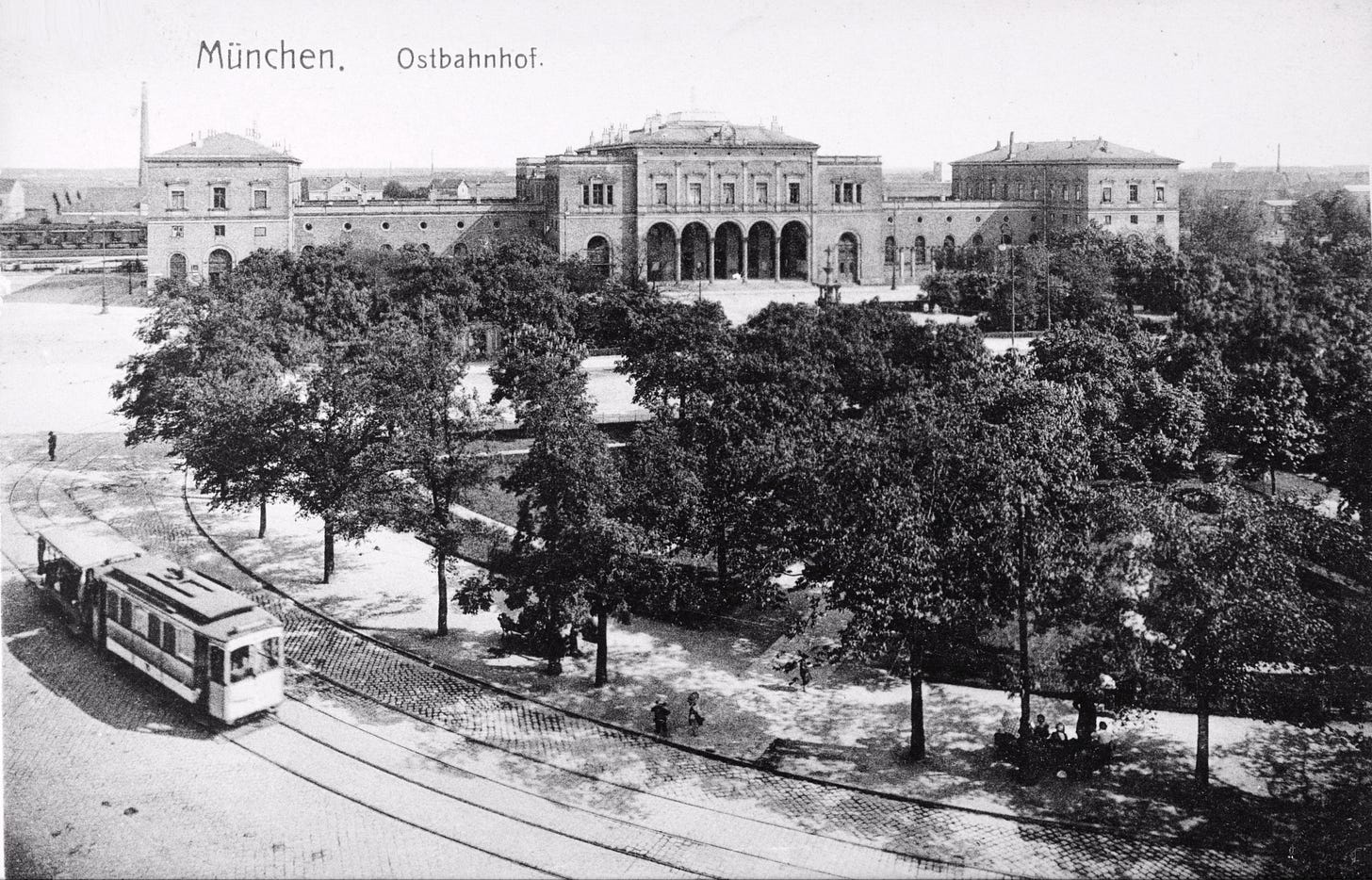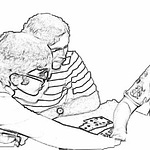I am making all three segments of Chapter 10 free to all readers. I want you to get a good glimpse of the humanity of these students, how they could have fun together, their dynamics in a group setting, simply their silly, serious selves.
July 22 - July 23, 1942.
Summary:
Hans Hirzel enjoys a number of one-on-one conversations with White Rose friends at the farewell party. Alexander Schmorell discusses music, regaling the high school students with stories of Igor Stravinsky. Christoph Probst tells Hans Hirzel that he disapproves of Hans Scholl’s “activism.”
Despite that, Hans Hirzel observes that Christl’s repudiation of the National Socialist government was the most unshakable among all the friends.
A small group discusses White Rose leaflets, really leaflets in general. Several believe that leaflets are ineffective, because they are too associated with Communist methodology. Somebody expresses a favorable verdict about that technique for communicating antipathy to Hitler’s regime, because they tell of having seen the single word Sieg painted on the side of a house. A question mark replaced the nearly-requisite Heil.
Just as the party is breaking up, someone mentions a “great woman” they should have invited. Hans Scholl calls her, and she comes right over. She talks to Professor Huber as if they are old friends, and he has no clue who she is. Apparently her husband is Huber’s friend?
Kurt Huber is first to leave at 11 p.m., followed closely thereafter by Traute and Käthe. Around midnight, Hans and Sophie Scholl accompany Hans Hirzel to the home of the Klein family, where he is staying. Hans Hirzel tries to ask about White Rose leaflets, but struggles to find the words. When he musters up one feeble question — did Hans Scholl know the origin of the leaflets — Hans Scholl does not answer directly.
Hans Hirzel also asks how they know that what they are saying about National Socialist crimes is true? After initially sidestepping an answer, Hans Scholl promises he will look into it and send proof to Hans Hirzel.
Hans and Sophie drop in on Traute - yes, after midnight. The three friends talk through the night, until Hans and Sophie leave for the Ostbahnhof, the East Train Station. Traute does not go with them, but she lends Sophie her bicycle.

While the soldier students mill around inside the fenced enclosure, Sophie climbs on the railing to eavesdrop. The five soldier students are elated to learn that they can travel together, and they get a compartment all to themselves. The five soldier students: Alexander Schmorell, Hans Scholl, Willi Graf, Hubert Furtwängler, and Raimund Samüller.
After the train pulls out at 11 a.m., Sophie turns to go back to her room. She realizes that in all the commotion, someone had stolen Traute’s bike.
2007 update
The friends — Hans, Sophie, Alex, and likely Traute — spend Sunday, July 19, 1942, with the Probst family in Zell. They realize that this could be a final farewell. Christl still does not know where he will be doing his clinical rotation.
Anton Wagner, a soldier from the student company, is also on the train with the soldier students. Anton was never part of White Rose, but he shows up now and again. Remember his name.
Why this matters:
Traute Lafrenz’s ability to love is unsurpassed among White Rose friends. I am in awe of her genuine friendship with Hans and Sophie Scholl, despite everything. If she had allowed herself to be run off by Hans’ demeaning and belittling words, or by Sophie’s disdain, White Rose work would have suffered. She loved them, even when they would not love her.
She is example for us all.
Note: Not recommending staying in abusive relationships. She did not “stay” with Hans!When we set about the hard work of righting wrongs or repairing the world or simply taking a stand, often the hardest thing to overcome is simply finding agreement regarding methodology. For White Rose: Leaflets? Placards? Graffiti? What about active resistance? For us, the choices may be between social media, volunteering, pounding the pavement. Choosing a course of action can sometimes be the biggest obstacle to success.
Have you been part of a group working for social justice, and gotten stumped by process? Talk about it here!
White Rose History, Volume II, pages 132-135.
Notes and references
The last part of the party (including Hans and Sophie to Traute’s room):
Hans Hirzel placed his conversation with Alexander Schmorell (Igor Stravinsky) as the day after the party, which was impossible, since Alex was on his way to Russia.
Regarding Manfred Eickemeyer not being present for the debate: Since he had confessed to so much, it is inconceivable that he would have lied about a relatively small point. However, Eickemeyer’s claim that “had he known about the leaflets, he would have broken off contact with Hans Scholl et al” is not credible.
Katharina Schüddekopf confessed to the conversation with Hans Scholl about the leaflets. She also just as clearly stated that no one else heard their conversation.
Regarding the “great woman”: It has always been assumed she was a “great” woman. She could have simply been large [eine grosse Dame]. There are no sources that point to her identity. It would not have been Mrs. Mertens, because she would have been well known by all. Maybe Dr. Paugger? But that is complete conjecture. Traute assumed she was one of Eickemeyer’s friends. She never reappeared in White Rose circles that we know of.
Katharina Schüddekopf had initially claimed she left the party at 9:30 pm because she was exhausted. She had to recant her testimony after Kurt Huber’s interrogation, finally admitting that he was right.
The word Traute Lafrenz used for sensual was sinnlich, which has the connotation of being controlled by one’s emotions.
Hirzel, Hans. “Flugblätter der Weiβen Rose in Ulm und Stuttgart.” In Rudolf Lill (Ed.). Hochverrat? Die “Weiβe Rose” und ihr Umfeld (pp. 89-119). Konstanz: Universitätsverlag Konstanz, 1993.
October 1996 interview with Dr. Traute Page nee Lafrenz at her residence.
Gestapo Interrogation Transcripts: Eickemeyer and Grimminger, Volume 1. Stadtsarchiv München Stanw. Nr. 12.530. 4/7/43 interrogation of Manfred Eickemeyer.
NJ1704, Volume 7. 3/19/1943 interrogation of Professor Huber; 2/27/1943 interrogation of Professor Huber.
ZC13267, Volume 6. 3/15/1943 interrogation of Traute Lafrenz; 3/19/1943 interrogation of Traute Lafrenz; 4/3/1943 interrogation of Traute Lafrenz. Publication in 2024/2025.
ZC13267, Volume 15, part 2. 3/24/1943 interrogation of Katharina Schüddekopf.
ZC14116, Volume 1. 2/27/1943 interrogation of Hans Hirzel in Munich; 2/22/1943 interrogation of Hans Hirzel; 3/8/1943 “letter” written by Hans Hirzel (explanation of his philosophy of life). Publication in 2024/2025.
The soldier students at the Ostbahnhof:
The other woman standing next to Sophie Scholl in Wittenstein’s photograph has never been identified. Wittenstein says he does not know who she was.
Until October 1996, I had assumed it was Traute Lafrenz. When I asked her, she said it was not (and then told me the other things about 7/22-7/23/42 included here).
2023 note: To be updated in 2025 update, but it was likely Lilli Holl, a friend from Ulm. Lilli was close to Otl Aicher, and also to Alexander Schmorell. After Alex’s execution in July 1943, she took photographs from the departure at Ostbahnhof to the Schmorell family. As far as I know, those photographs have not been found. Apparently Lilli did not keep a copy.
Anyone who says it was Traute did not ask her!
Wittenstein has repeatedly claimed that he, Alex, and Hans were in one compartment, while Hubert, Raimund Samüller, and Willi Graf were in another. Since that contradicts the above, Armin Ziegler asked Hubert Furtwängler about the matter. Furtwängler claimed that Wittenstein was not in the compartment with them.
Wittenstein’s account is so riddled with errors and contradictions (e.g., sometimes he says they were in the train for two weeks, sometimes for three, while Willi Graf’s diary firmly documents that they were in the train for nine days, period), it is not worthwhile to replicate Ziegler’s excellent analysis here. But it’s assuredly worth understanding!
Aicher-Scholl, Inge. Sippenhaft: Nachrichten und Botschaften der Familie in der Gestapo-Haft nach der Hinrichtung von Hans und Sophie Scholl. Frankfurt am Main: S. Fischer Verlag GmbH, 1993.
Jens, Inge (Ed.). At the Heart of the White Rose: Letters and Diaries of Hans and Sophie Scholl. Translation by J. Maxwell Brownjohn. New York: Harper & Row Publishers, Inc., 1987.
Knoop-Graf, Anneliese and Jens, Inge (Eds.). Willi Graf: Briefe und Aufzeichnungen. Frankfurt am Main: Fischer Taschenbuch Verlag GmbH, 1994.
October 1996 interview with Dr. Traute Page nee Lafrenz at her residence.
May 2002 interview with Herta (widow) and Michael (son) Probst at their residence.
January 2001 interview with George J. (Jürgen) Wittenstein at his residence.
Ziegler, Armin. “Gehörte Jürgen Wittenstein zum inneren Kreis der ‘Weiβe Rose’?” Retrieved from www.weisse-rose-studien.de/41604.html.
Ziegler, Armin. Jürgen Wittenstein und die Geschichte der ‘Weiβe Rose’: Ein Beitrag zur ‘Weiβe Rose’ Forschung. Schönaich: Self-published, 2004. I received advance (pre-publication) copy.
2007 update:
Volkmann, Robert, and Gernot Eschrich, Peter Schubert (Ed.). “…damit Deutschland weiterlebt”: Christoph Probst 1919-1943. Gilching, Germany: Christoph-Probst-Gymnasium, 2000.
RGWA I361K-1-8808. Alexander Schmorell: Gestapo Interrogation Transcripts. 3/11/1943 interrogation of Anton Wagner; 3/1/1943 interrogation of Alexander Schmorell.
Next segment goes back to “notes and references for paid subscribers only.” I hope you enjoyed Chapter 10, and this glimpse into their world.
Why This Matters is a reader-supported publication. To support our work, consider becoming a paid subscriber. - All subscription funds are deposited directly to the account of Center for White Rose Studies, a 501(c )(3) nonprofit. Ask your tax accountant if your subscription is tax deductible.
Podcast © 2024 Denise Elaine Heap. White Rose History, Volume II, Chapter 10, © 2002 Denise Elaine Heap and Exclamation! Publishers. White Rose History, Volume II, Chapter 10, 2007 update, © 2007 Denise Elaine Heap and Exclamation! Publishers. Please contact us for permission to quote.
This podcast is a project of WHY THIS MATTERS, a newsletter of Center for White Rose Studies, that explores the reasons that voices silenced more than eighty years ago still speak to us today.
To order digital version of White Rose History, Volume II, click here. Digital version of White Rose History, Volume I is available here.














Share this post